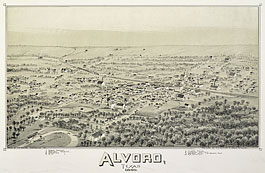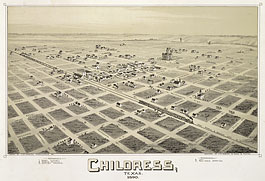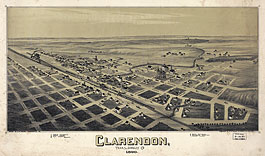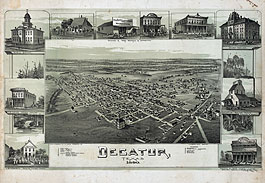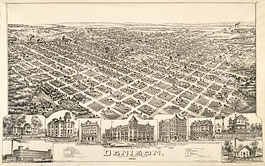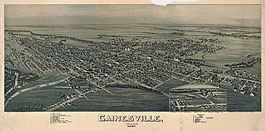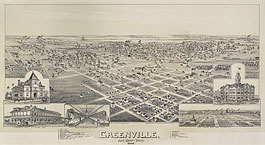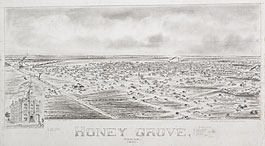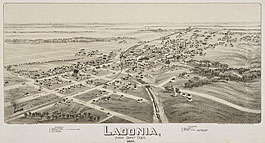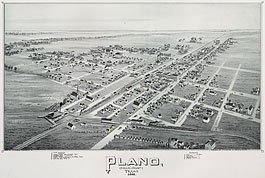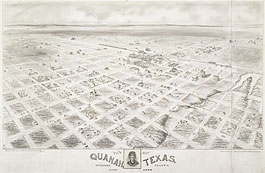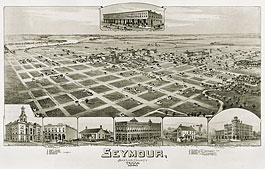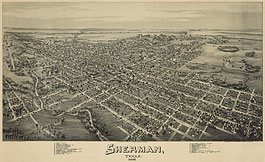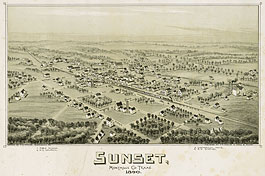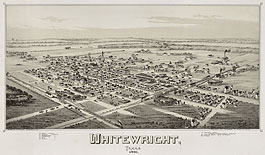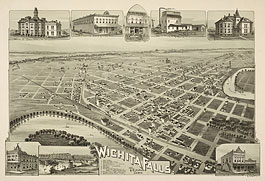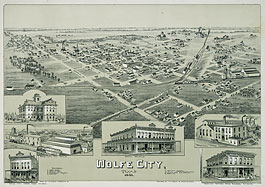Alvord in 1890
The Fort Worth and Denver City Railway reached Alvord, about 13 miles from Decatur, early in 1882 as a part of the company’s pell-mell rush to meet the construction crews from Denver in the Texas Panhandle. The small Wise County town had begun life as Nina, a tent city on the railroad about fifty miles north-northwest of Fort Worth. It was named Alvord in honor of the president of… [More]
Childress in 1890
Traveling along the Fort Worth and Denver City Railroad, Thaddeus Fowler reached Childress, in Childress County a few miles south of the Prairie Dog Town Fork of the Red River. Childress County had been organized during the 1880s as the railroad was built through the region. Childress City and Henry, two fledgling communities about four miles apart, competed for county seat, and Childress City won the election. This meant… [More]
Clarendon in 1890
Clarendon, the county seat of Donley County just east of the Llano Estacado, is the westernmost city in Texas that Fowler documented. The city was founded as a religious colony in 1878 and named either after Clara, the wife of Methodist minister and founder, Lewis Henry Carhart, or perhaps after Clarendon, England, to honor an English firm that backed Carhart’s endeavor. Carhart purchased 343 sections of land in the… [More]
Decatur in 1890
The Fort Worth and Denver City Railroad, linking Fort Worth with West Texas and finally with Denver, provided Thaddeus Fowler the opportunity to document the massive movement of population into West Texas during the last two decades of the nineteenth century. The use of barbed wire and windmills had rendered semi-arid West Texas somewhat less formidable, and farmers using relatively new dry-land techniques had brought cotton to the Panhandle… [More]
Denison in 1891
Thaddeus Fowler perhaps began his second tour of Texas with his picture of Denison, a growing city with a population approaching 11,000 by 1891. On January 11, The Sunday Gazetteer reported that the artist had been in the city for several weeks making pencil sketches for the new bird’s-eye view, which would be much larger than previous views of the city. “It is believed to include every residence within… [More]
Gainesville in 1891
Gainesville continued to grow in the years between Augustus Koch’s visit in 1883 and Thaddeus Fowler’s in 1891, due partly to the arrival of two additional railroads: the Santa Fe in 1886 and the Gainesville, Henrietta and Western Railway in 1887. Almost 6,600 persons called the city their home by 1890, perhaps double the population of 1883. Unlike some communities that suffered when the trail drives came to an… [More]
Greenville in 1891
For a city that waited longer than most for the railroad, Greenville had become a rail center by the time of Fowler’s visit in 1891. In addition to the Missouri, Kansas and Texas, the East Line and Red River, and the Dallas and Greenville railways, the St. Louis Southwestern arrived in 1887 and the Texas Midland in 1896, five years after Fowler’s view. Hunt County was no longer an… [More]
Honey Grove in 1891
Fowler included Honey Grove in his 1891 tour of North Texas and produced an elaborate drawing of the city, highlighted with blue pencil and wash, but there is no record that it was ever lithographed. Perhaps the economic situation had worsened for Honey Grove merchants and farmers since Henry Wellge’s 1886 visit; or perhaps they believed that Wellge’s handsome lithograph had not paid sufficient dividends and were unwilling to… [More]
Ladonia in 1891
The population of Ladonia, in the southeastern corner of Fannin County, numbered around 1,000 when Fowler visited in 1891 to make this view of the city. It is doubtful that there would have been a sufficient market for Fowler’s views among so few citizens themselves, in Ladonia or any of the other small towns that the bird’s-eye view artists documented. Perhaps several entrepreneurs or city officials took it upon… [More]
Plano in 1891
Plano is known today as a suburb of Dallas, completely engulfed by the larger city along with other nearby communities. But in 1891 when Fowler made this view, Plano stood separate and apart, with an economy that had begun to develop as a result of the arrival of the railroads in the previous decades. The first Anglo-American settlers in Collin County, prior to the Civil War, engaged mainly in… [More]
Quanah in 1890 (drawing)
Like Henry Wellge’s drawing of Honey Grove, this drawing by Fowler of Quanah is very rare. Once completed, such drawings were then sent to a lithography studio, where artists translated them into multiple lithographic prints. In most cases, the one-of-a-kind sketches then disappeared. Along with its derivative lithograph, this drawing has added historical importance because Quanah was struck by both flood and fire the year after Fowler finished his… [More]
Quanah in 1890 (lithograp)
The fact that Quanah was named for the Comanche chief Quanah Parker testifies to the centuries of Indian presence in the area that became Hardeman County in 1858 and explains why there was little Anglo-American settlement in the area until the 1880s. That began to change in 1884 as the Fort Worth and Denver City Railway worked on the road beyond Wichita Falls. The railroad surveyors laid out Quanah… [More]
Seymour in 1890
The Seymour that Thaddeus Fowler depicted in 1890 seemed to be a prosperous county seat with more large, stone buildings than such a small community, which was not even listed separately in the census of 1890, might justify. The substantial buildings resulted from a boom that coincided with the construction of the Wichita Valley Railroad to Seymour, located on the Brazos River, in 1890. The boom began when the… [More]
Sherman in 1891
The Texas Legislature established Sherman as the seat of government for Grayson County in 1846, and by 1860 the city had incorporated and become an important trading center for farmers in the surrounding area. The growth continued with the arrival of the Houston and Texas Central Railway in 1872, but because the city did not offer enough support, the Missouri, Kansas and Texas line chose to establish a new… [More]
Sunset in 1890
Sunset was among the communities that benefited from the construction of the Fort Worth and Denver City Railroad through northeast Texas. Located about eight miles northwest of Alvord, Sunset dates from the 1870s, when a few settlers arrived from Denton County. When the FW&DC built its line through the county in 1882, several residents moved to the site of Sunset to be near the tracks, and the small community… [More]
Whitewright in 1891
Like many other Texas cities, Whitewright owes its founding to the arrival of the railroad and the westward movement of cotton production out of deep East Texas. In 1878, as the Missouri, Kansas and Texas Railroad was making its way into the state, New York investor William Whitewright purchased a tract of land in the railroad’s right-of-way. He surveyed a town site and then brought in agents to conduct… [More]
Wichita Falls in 1890
The initial destination goal of the Fort Worth and Denver City Railroad as it built northwestward from Fort Worth toward the Texas Panhandle was Wichita Falls. The small community, which had attracted a scattering of settlers throughout the 1870s and established a post office in 1879, encouraged the railroad to build through the developing business district by donating land. The first construction train, with a single passenger car attached… [More]
Wolfe City in 1891
Wolfe City was founded in the late 1860s or early 1870s when J. Pinckney Wolfe built a mill near Oyster Creek in north-central Hunt County. For a while it was known as Wolfe’s Mill, but by the time it received a post office, the name had been changed to Wolfe City. Adding “city” to the name was an affectation that dozens of small towns in Texas and across the… [More]











